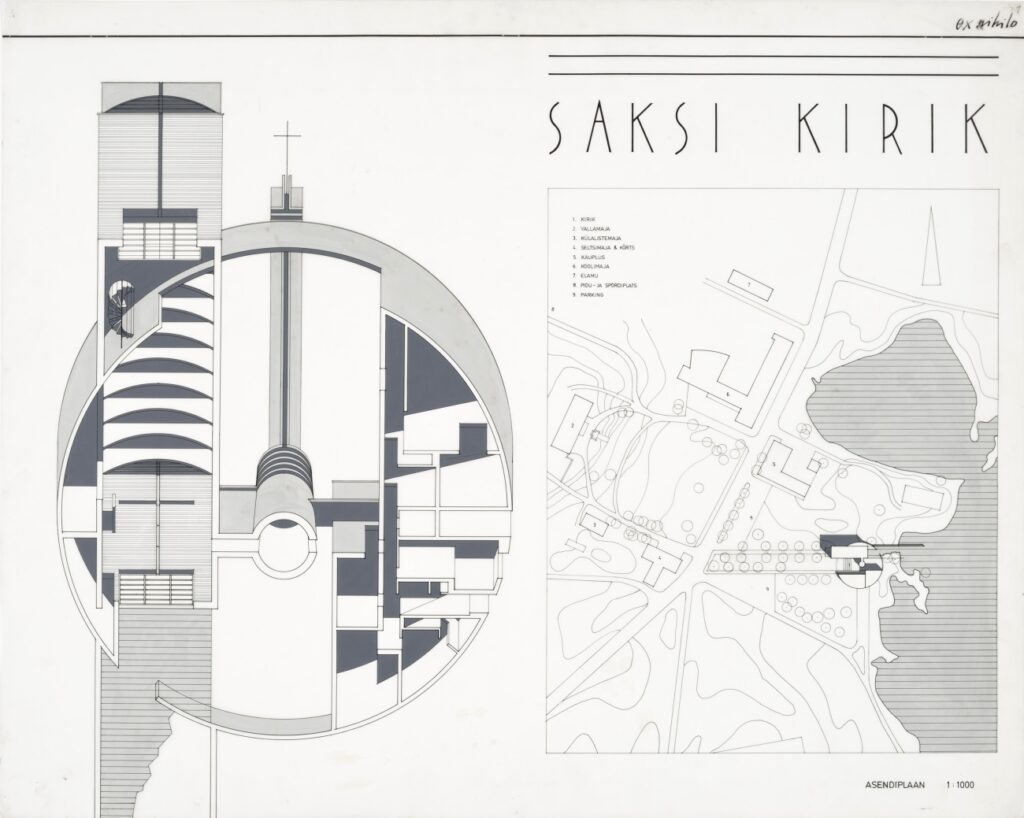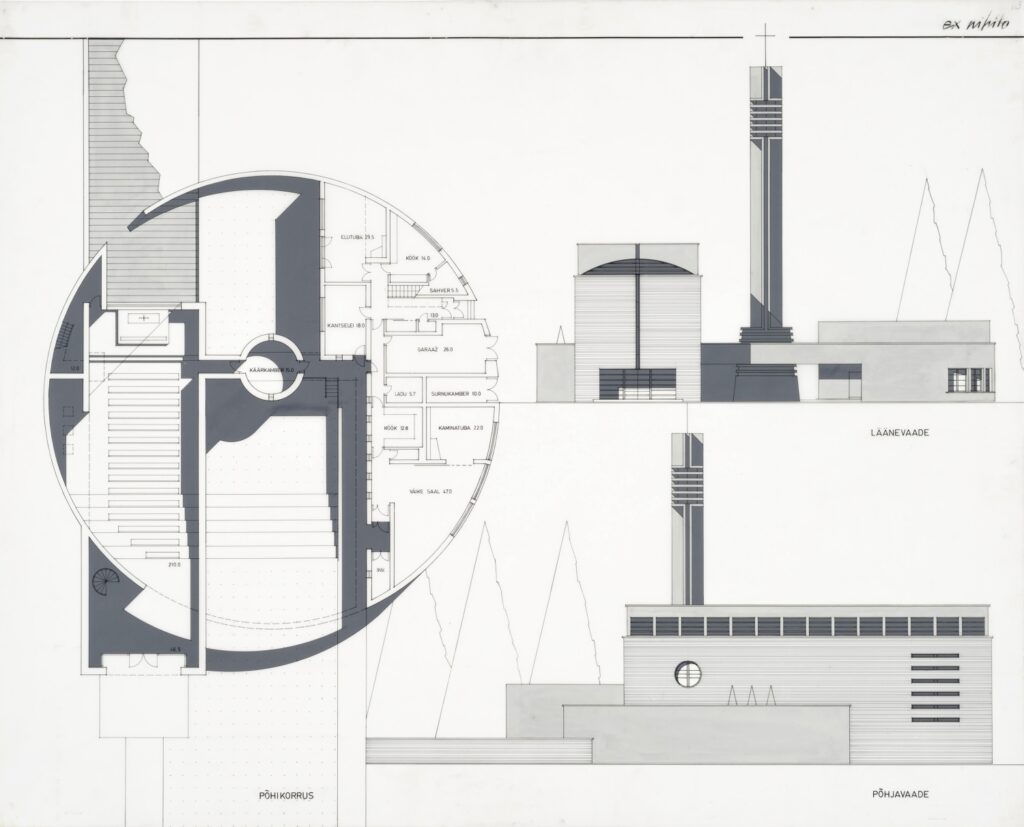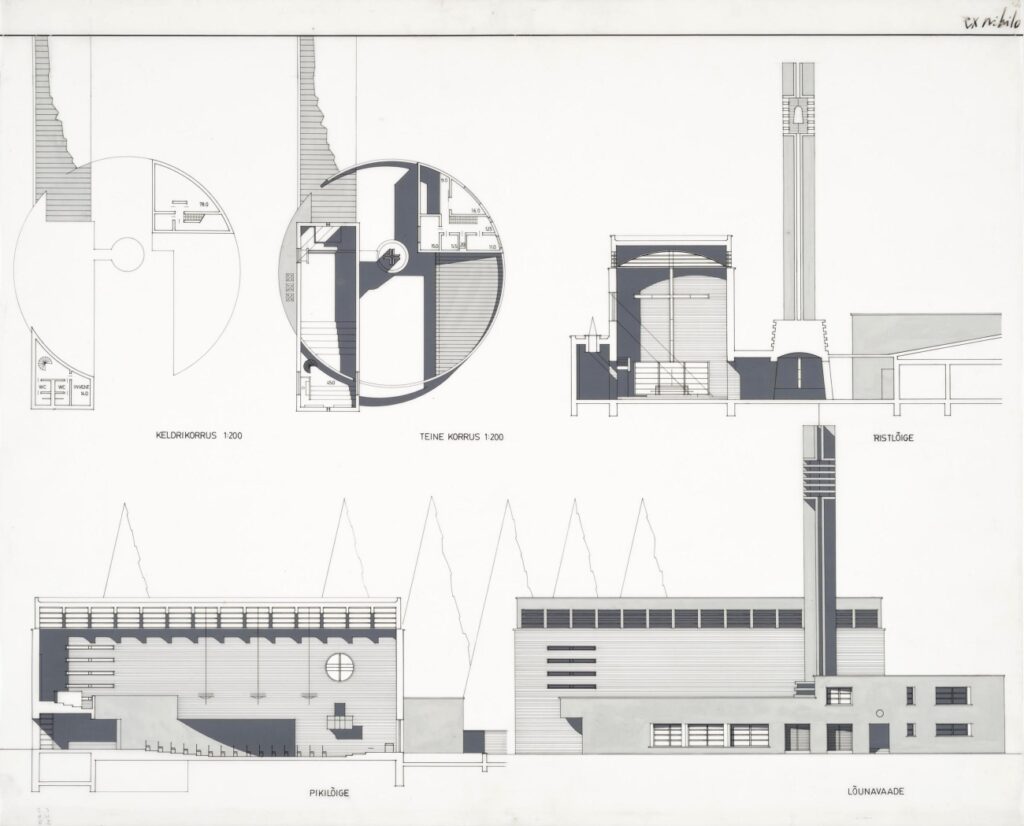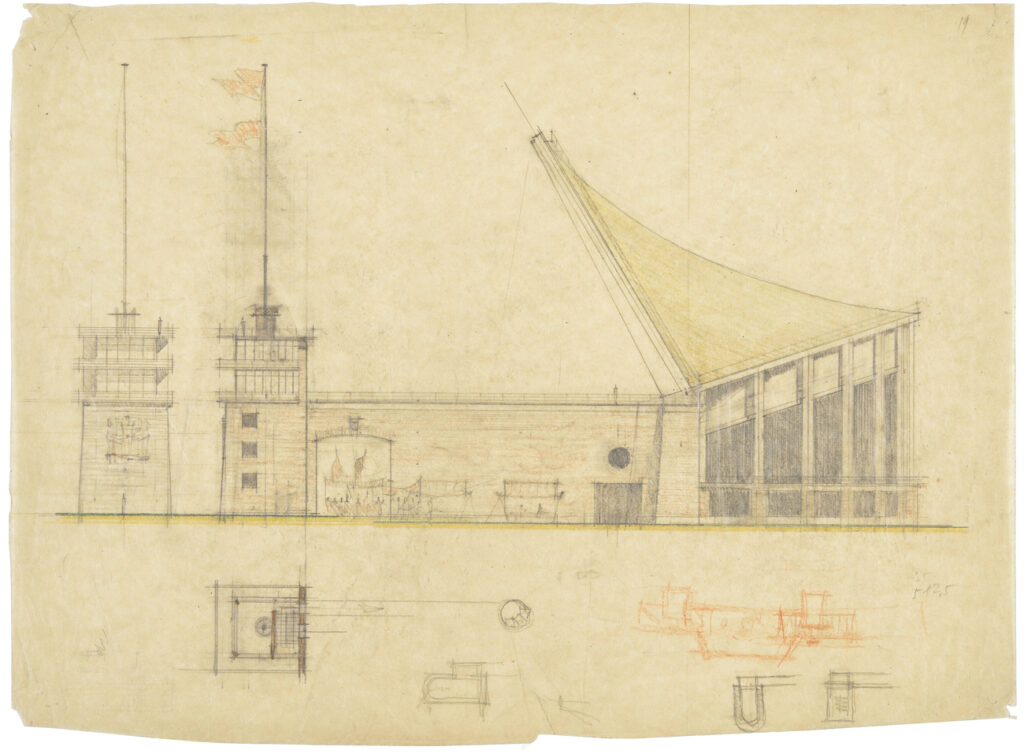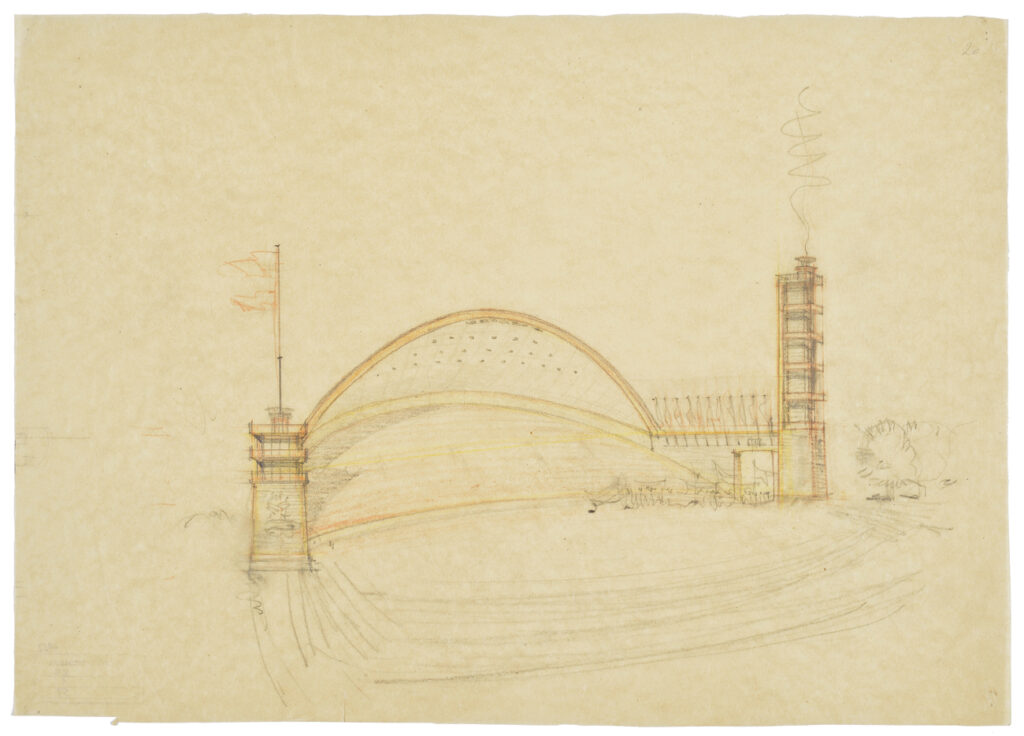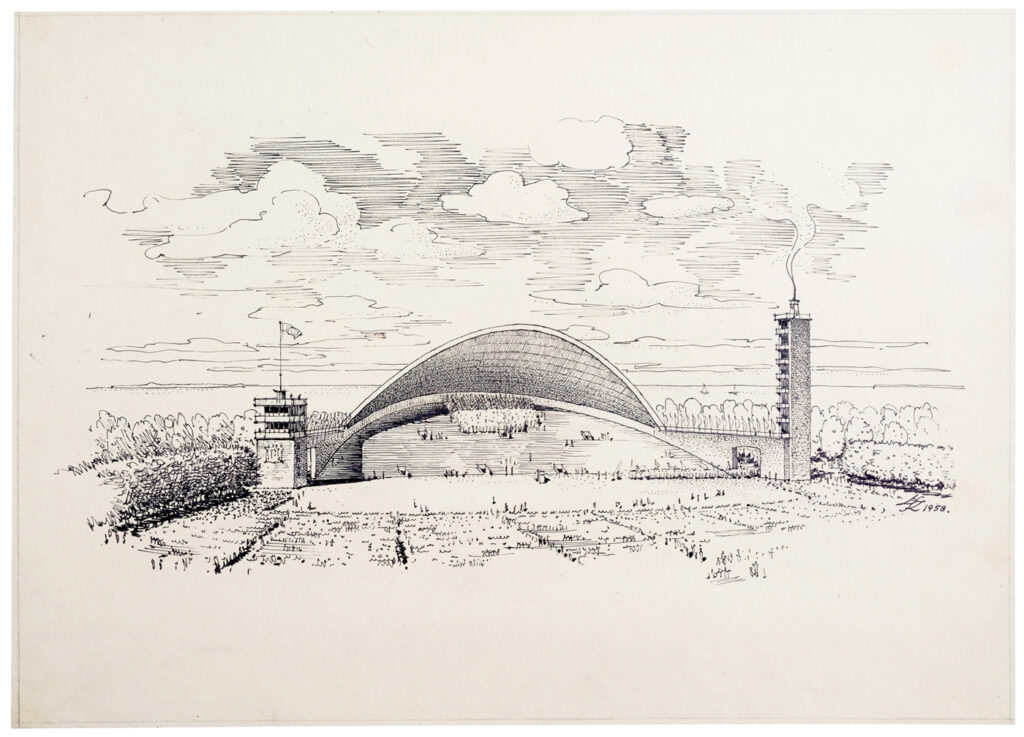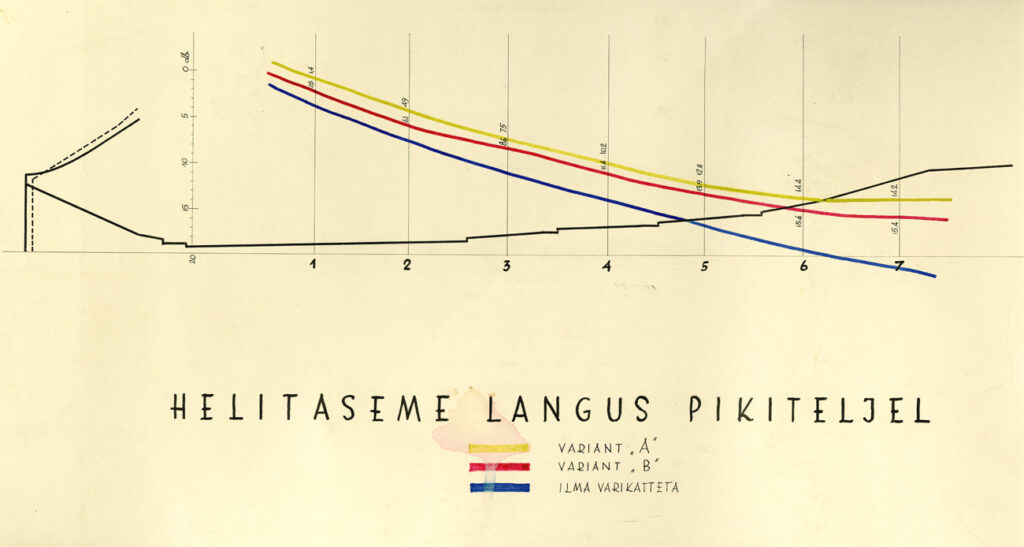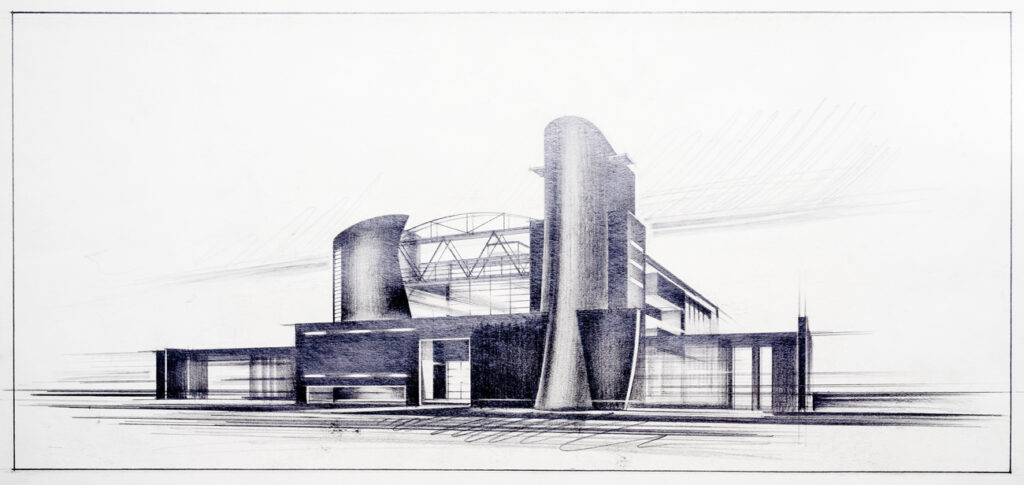Emil Urbel, 1989. MEA 5.4.7
Saksi Lutheran Church
New Estonian church architecture awakened from its long coma during the late 1980s. The more liberal atmosphere of perestroika opened up a new time of opportunity for sacral architecture. The design competition for a new Lutheran church on the shore of a lake in Lääne-Viru County was one of the first of its kind. The competition jury, composed of architects from Finland, Sweden, and Estonia, commended Emil Urbel’s winning entry for its flawlessly-proportioned façade and successful immersion into the landscape. Although post-modernism that flirted with motifs of historical architecture was dominant in the late 1980s, the jury preferred Urbel’s more universal and minimalist approach. Nonetheless, the building wasn’t realised. Emil Urbel donated the drawings “Ex nihilo” to the museum in 1993. Text: Sandra Mälk
-

-
City of the Living – City of the Dead
Leonhard Lapin, 1978. MEA 4.18.2
City of the Living – City of the Dead
In the 1970s, in order to voice common opinions and organise a number of social-critical exhibitions and undertakings, avant-garde architectural students united to form a group later called the Tallinn School. “Elavate linn – Surnute linn” (“City of the Living – City of the Dead”) is Leonhard Lapin’s satirical take on the construction of characterless mass housing. The author hid several important allegories in the drawing: the words “Väike õhkamine” (“Little Sighing”) stuck between the buildings symbolise the Pruitt-Igoe Modernist housing project in St. Louis, MO, USA (demolished in 1972); while “Autodes matmine” (“Burial in cars”) in the centre of the work references Lapin’s friend Vilen Künnapu (also an architect), who was one of the first members of the Tallinn School to acquire a vehicle. The drawing was displayed at the Library of the Estonian Academy of Science in 1978 among other works of which many were donated to the museum by engineer Reet Lumiste in 1991.
Alar Kotli, 1957-1958. MEA 23.1.51
Tallinn Song Festival Arena (sketch)
The Tallinn Song Festival Arena represents the re-arrival of modernism to Estonia during the Khrushchev Thaw. The Estonian SSR leadership commissioned the structure to mark the 20th anniversary of Soviet rule, but to Estonians, it was a symbol of their nationality and culture. The Song Festival Arena was essentially also a way of the nation thumbing its nose at the USSR – with its completion, Estonians’ nearly 100-year tradition of holding mass song festivals was immortalised. Alar Kotli came close to an entirely innovative final solution already when making his initial sketches, which include a saddle-roof in the shape of a hyperbolic paraboloid that functions as an acoustic screen. The sketches were donated to the museum by Anu Kotli in 1997. Text: Sandra Mälk
Urmas Muru, competition in 1988, II prize. MEA 5.5.3
Computation Centre in Pärnu
In the 1980s young architects Raoul Kurvits, Peeter Pere, and Urmas Muru formed the radical Rühm T (Group T) artists’ group, which proclaimed that architects are artists, also. Urmas Muru’s vision for the Pärnu Computation Centre was a graphical Neo-expressionist design that was characteristic of Rühm T’s works. The strong angle of perspective and black-and-white pencil tones proceed from buildings of technical function and appearance. This led to a unique style that Kurvits and Muru termed “technodelic expressionism”. They described ‘technodelics’ as a revelation of the technical world through trance. The museum acquired the drawing in 1993 from Urmas Muru.
Peeter Tarvas, 1943. EAM 40.1.1
Ellamaa power plant annexe
The Ellamaa power plant was opened on May 9, 1923. The outstanding industrial building, designed by architect Aleksandr Wladovsky, consisted of a switch and transformer building, a machine building, a peat gas generator building and a tower with a water tank at the top. By the end of the decade, the rapid growth of electricity consumption made it necessary to add a few buildings to the complex. During the war in 1941, a part of the power plant exploded. The building was soon restored according to a slightly different project from the original one, an extension was planned to increase the production capacity. In 1943, architect Peeter Tarvas prepared project for the restoration and reconstruction of the power plant. The architect placed a water tower in the center of the drawing, in the foreground are new substations added to the existing building. The annexe designed by Peeter Tarvas was not implemented. The Ellamaa power plant was closed in 1966, when the power supply was taken over by the kerogenite power plants located in Ida-Virumaa. The boiler house, which was completed in 1929, continued to operate and supplied the Turba village with room heat for a few decades after the power plant closure. Since 2018, the Motorsports Museum MOMU has been operating in the Ellamaa power plant building. Text: Anna-Liiza Izbaš
-
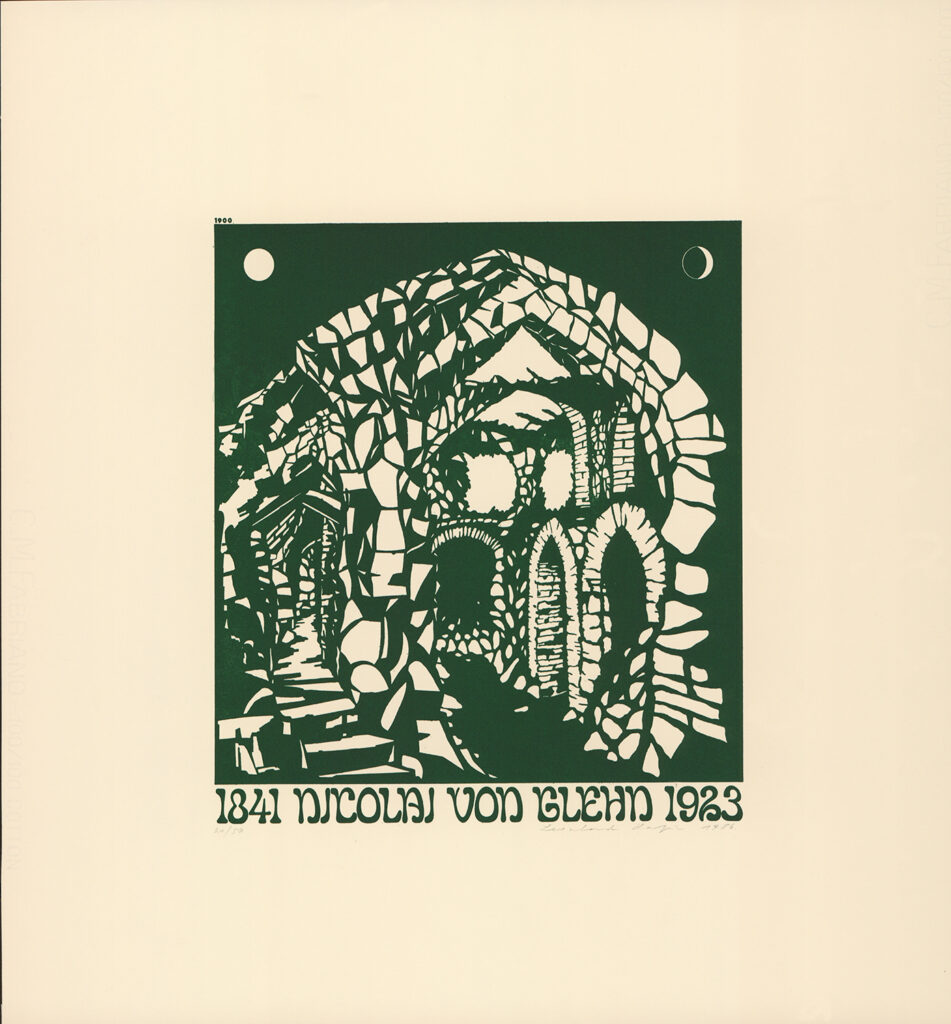
-
Nikolai von Glehn’s palm house in Nõmme
-
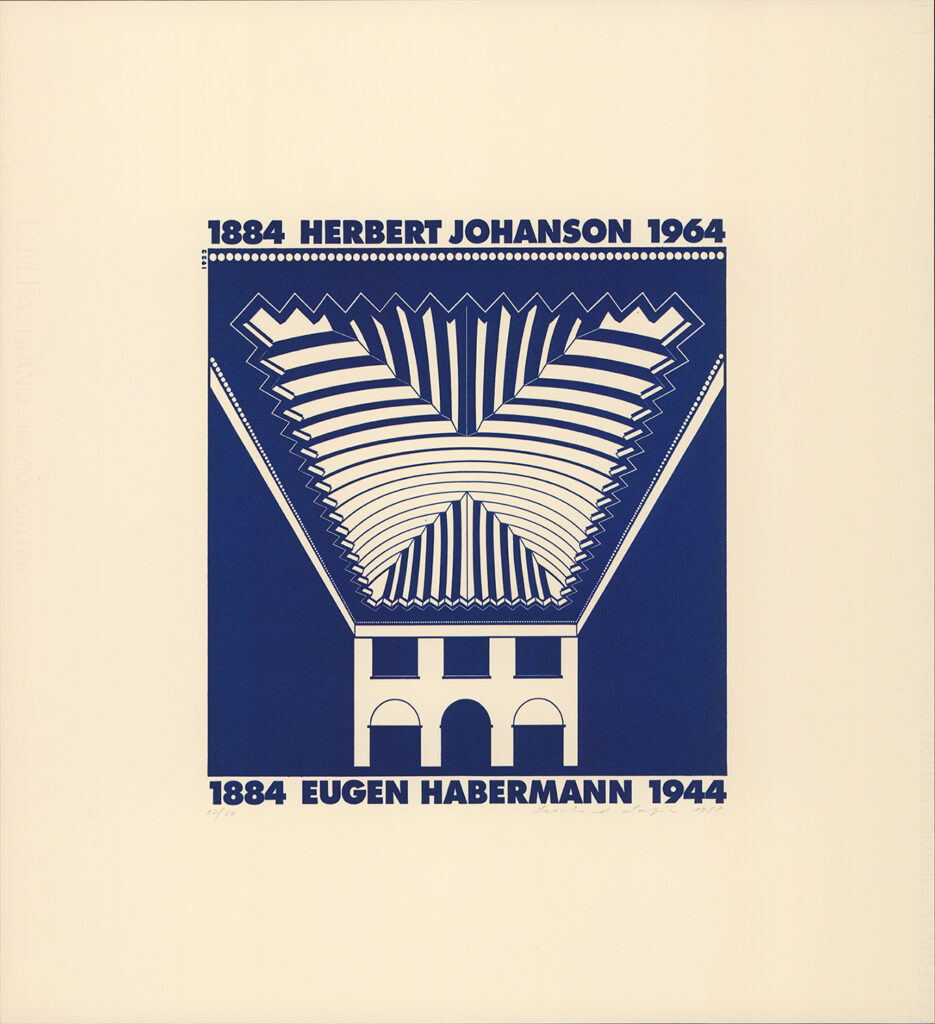
-
Herbert Johanson, Eugen Habermann. Riigikogu (1920–1922)
-
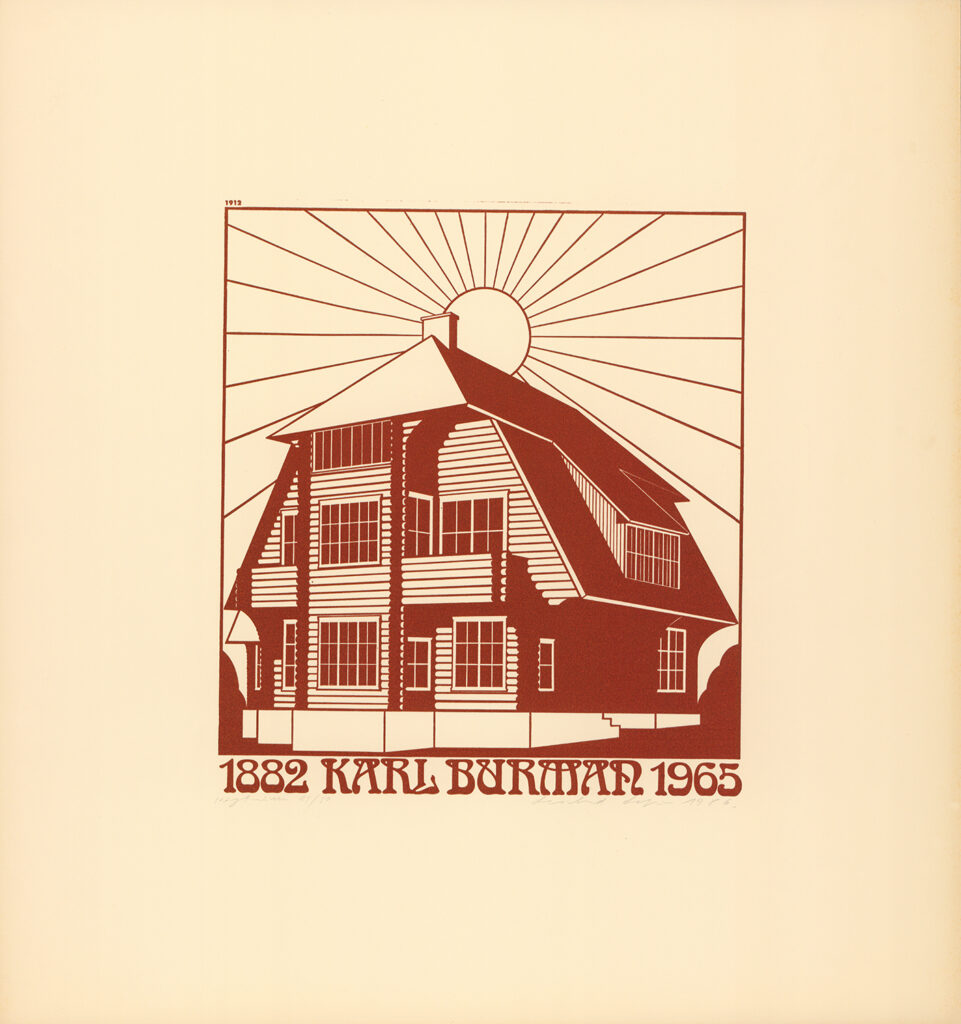
-
“Estonian Art of Architecture” by Leonhard Lapin
-
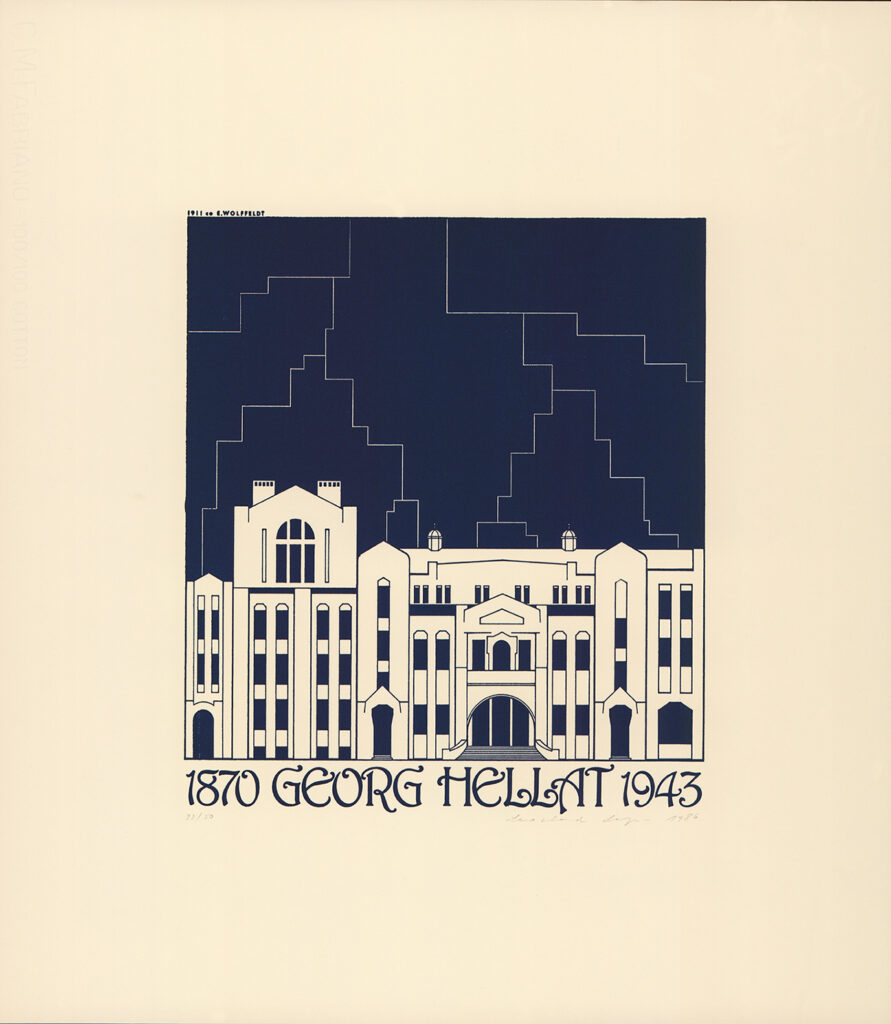
-
Georg Hellat ja Alfred Jung. Endla theatre-society hall in Pärnu (1911)
-
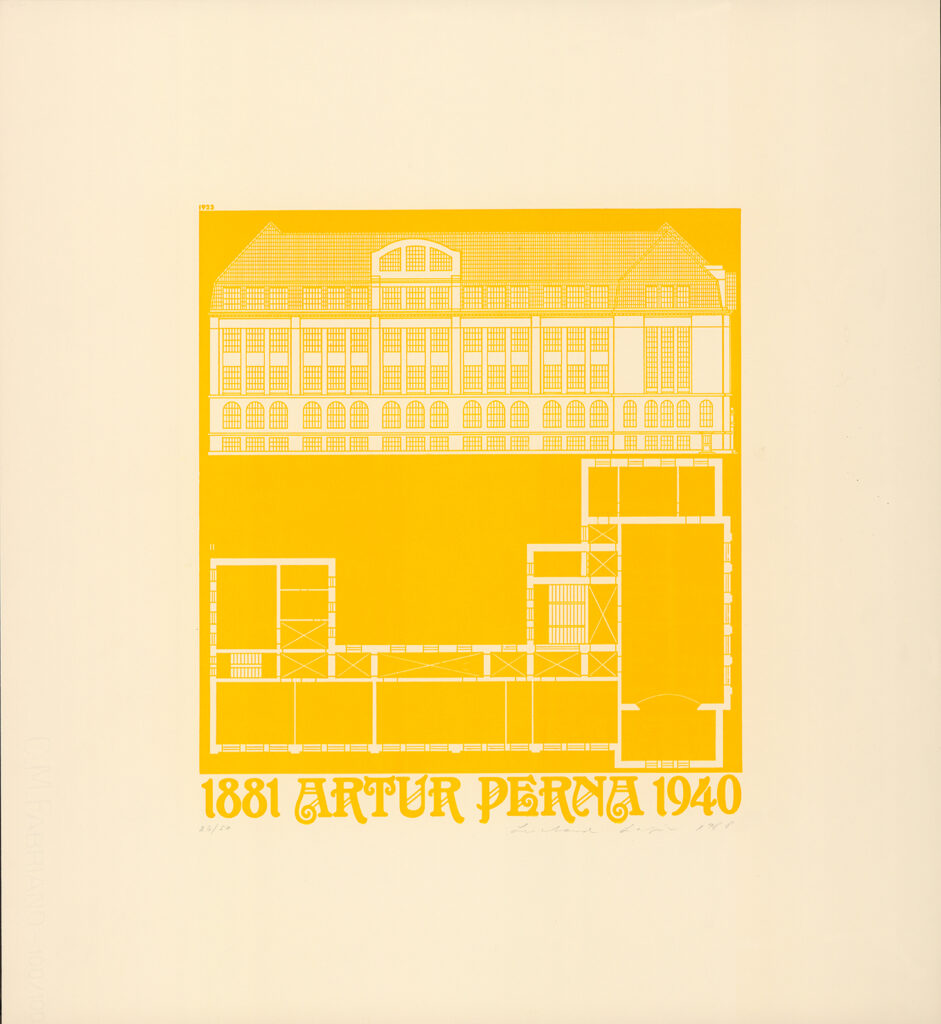
-
Artur Perna. Tallinn 21st School (1923)
Leonhard Lapin, 1986–1988. EAM fond 68
Graphic series “Estonian Art of Architecture”
On December 29, Leonhard Lapin would have celebrated his 75th birthday. Lapin’s legacy is characterized by bold modernist architecture, but his work was far from limited to that. Leonhard Lapin has published poetry collections and was an outstanding art innovator. Recognizable are his pop-art-influenced graphics, distinctive architecture in urban spaces and art galleries. Leonhard Lapin has kindly brought his projects and works of art to the architecture museum over the years. This year, the architectural drawings in the home archive arrived here with his legacy. As a heartfelt addition, Leonhard Lapin’s son and daughter gave the museum 5 colorful letterpress graphics from the 1980s. The series is called “Estonian Art of Architecture” and depicts the work of various masters from the early decades of the 20th century: Nikolai von Glehn’s Palm House, Georg Hellat’s Art Nouveau old Endla theater-society house, National Romantic Kalevi Yacht Club Pirital (Karl Burman), Herbert Johanson and Eugen Habermann’s Riigikogu building and Tallinn 21. School designed by Artur Perna. Text: Sandra Mälk
-
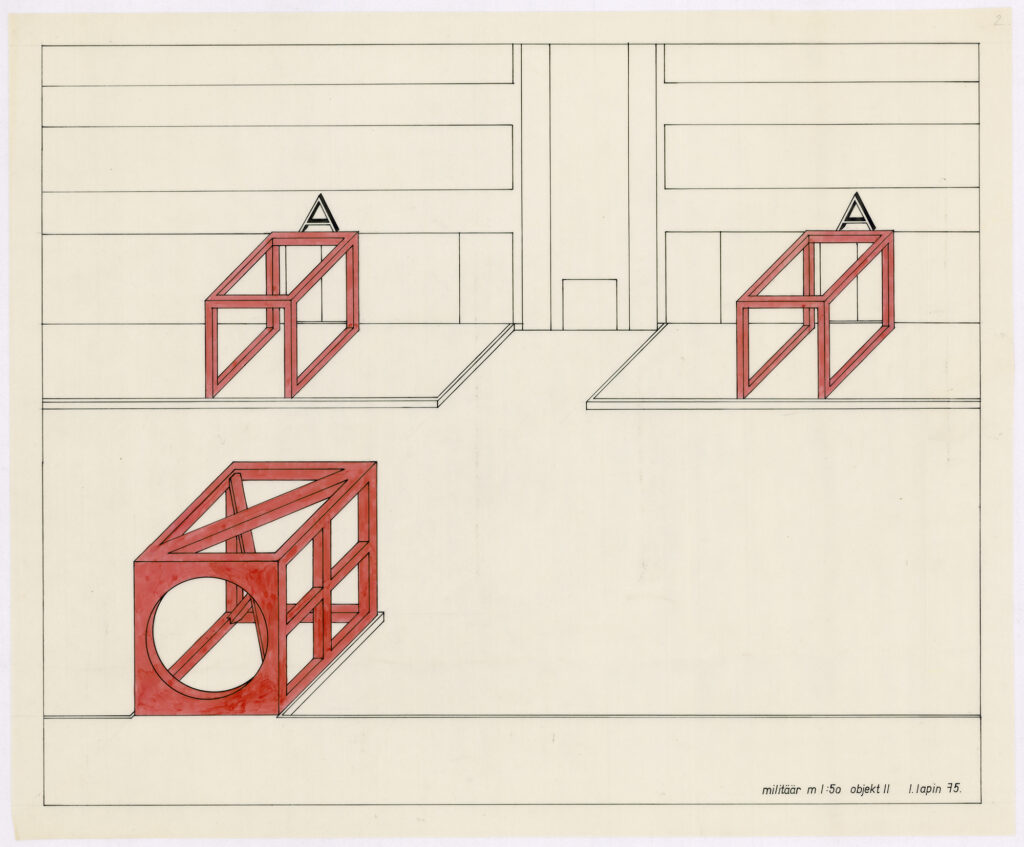
-
Signs in front of the entrances to the Pärnu KEK housing complex
-
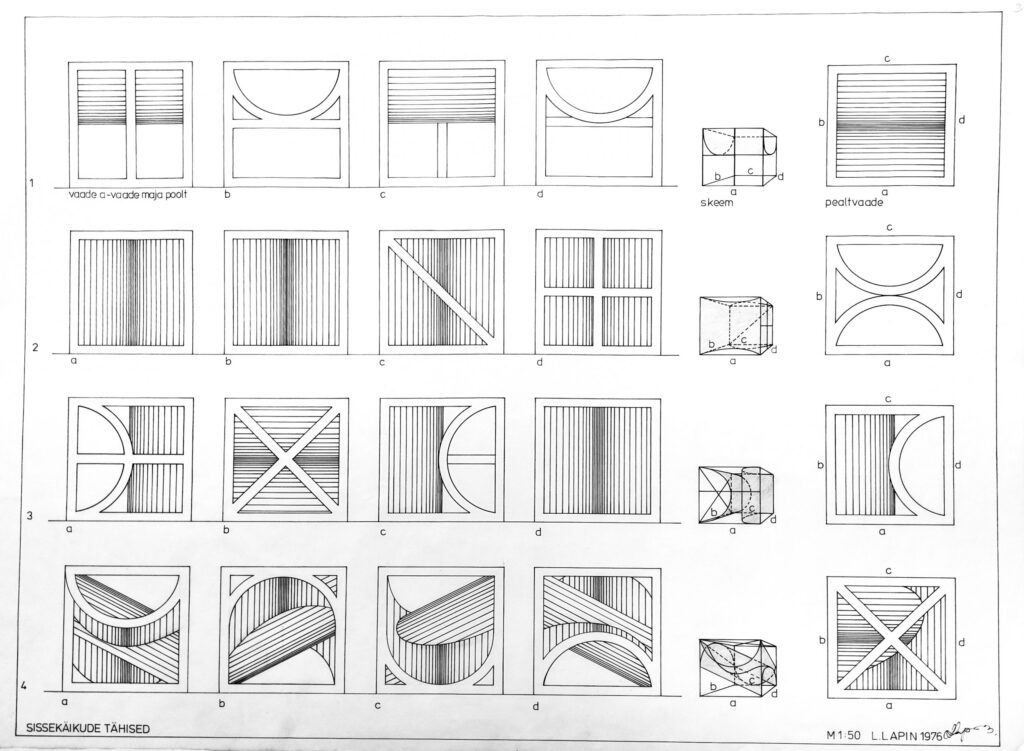
-
Sign variations of the Kuldne Kodu entrances, Leonhard Lapin
-
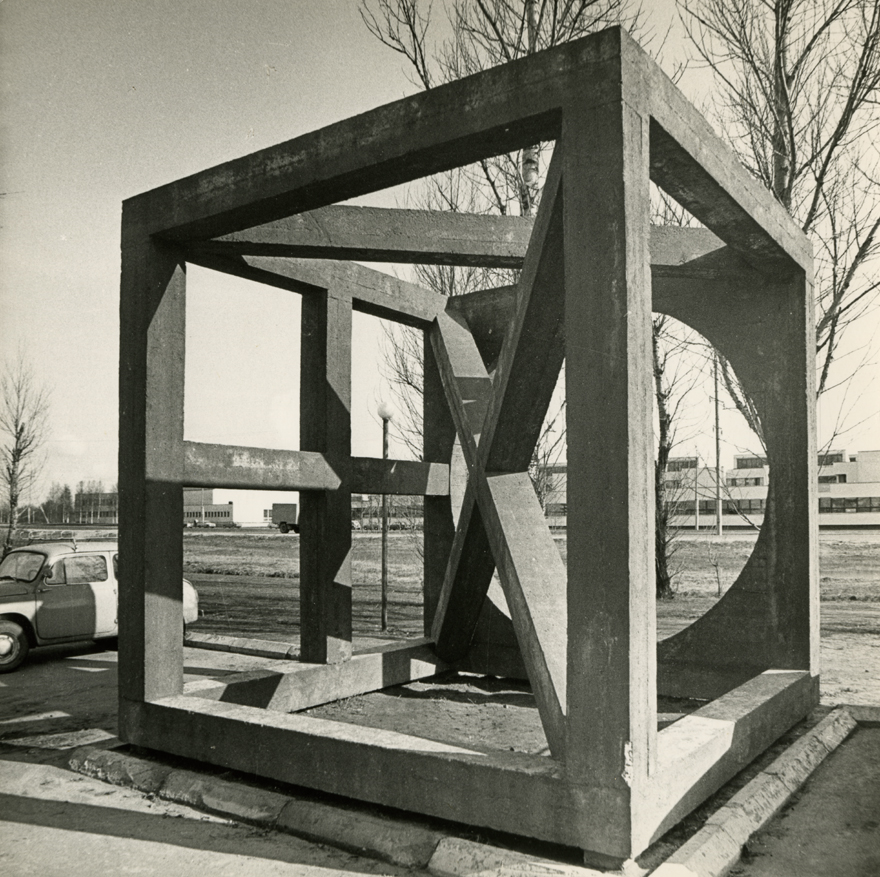
-
Concrete sign in front of a terrace house
Leonhard Lapin, 1975–1976. EAM 4.2.87 and Fk 821
Signs in front of the entrances to the Pärnu KEK housing complex
The housing complex of Pärnu KEK includes constructive signs that are located in front of the terraced house called “Kuldne Kodu” (Golden Home). Although concrete was still a rarity as a material in the 1970s, materials were more available for the construction offices of the collective farms (kolkhozes). In the same spirit the terraced house that was constructed in monolithic concrete was completed with concrete-poured sculptures. According to Leonhard Lapin, the sculptural architectons offer a great way to present different ideas, and since it is free of restrictions, the small form allows to present the ideal architecture. The constructions in blue and other bright tones were more than just ideas, in fact. A monolithic structure with a different structure and color was planned in front of each entrance, so it was easy to find the right staircase of a terrace house that was about a kilometer long. In addition to directing, the architectons offered a rare view of abstract sculptures that were scarce in the Soviet public space. As well as the residential area itself, the signs were not fully implemented. In 2008, Andres Ringo handed over the architects’ drawings to the museum. Text: Sandra Mälk
(click on the picture to see more examples)




